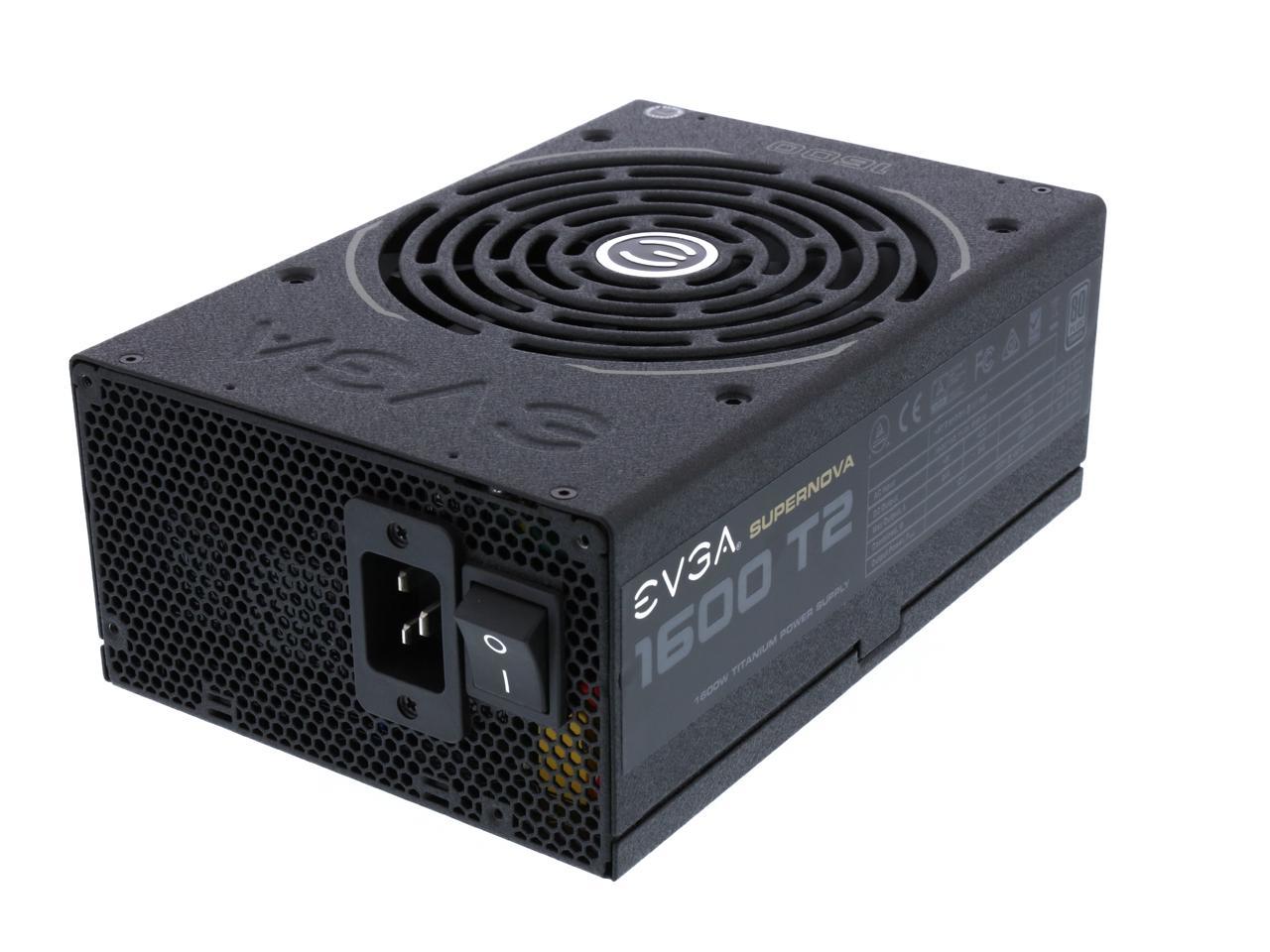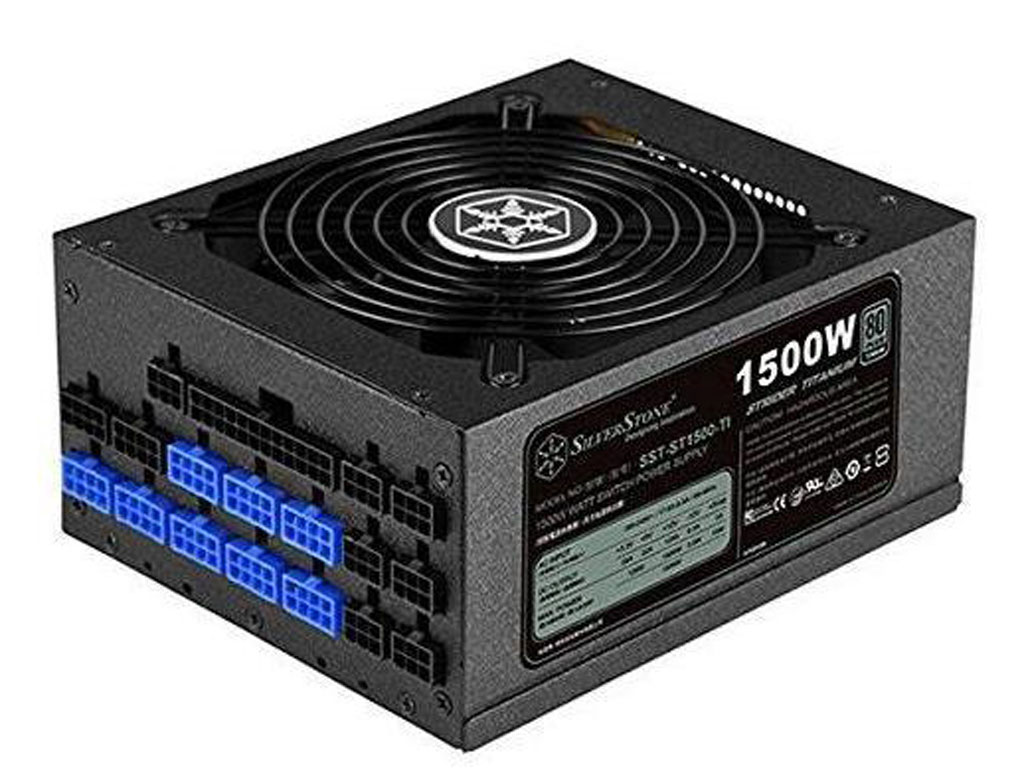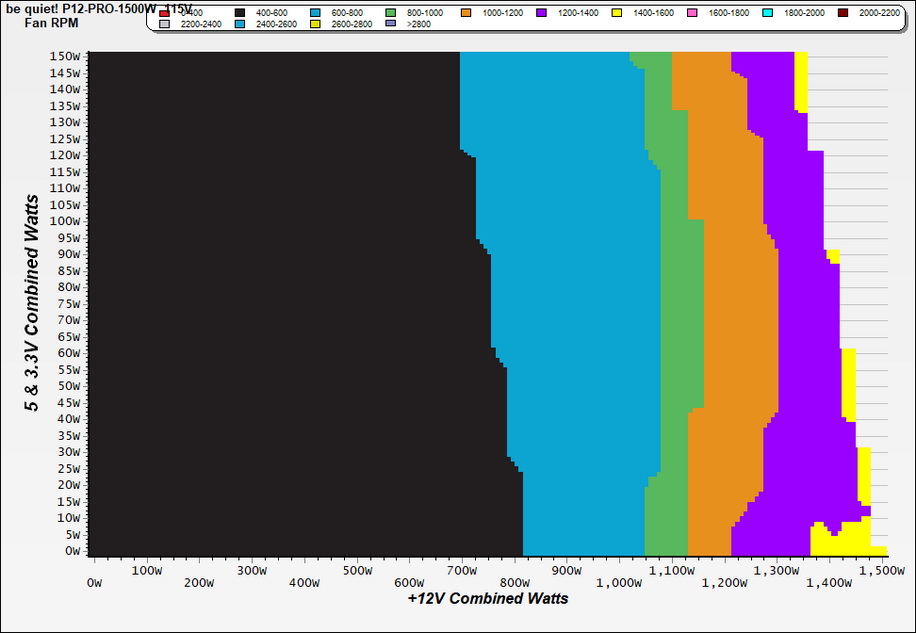Why you can trust Tom's Hardware
To learn more about our PSU tests and methodology, please check out How We Test Power Supply Units.
Primary Rails And 5VSB Load Regulation
The following charts show the main rails' voltage values recorded between a range of 40W up to the PSU's maximum specified load, along with the deviation (in percent). Tight regulation is an important consideration every time we review a power supply because it facilitates constant voltage levels despite varying loads. Tight load regulation also, among other factors, improves the system’s stability, especially under overclocked conditions and, at the same time, it applies less stress to the DC-DC converters that many system components utilize.
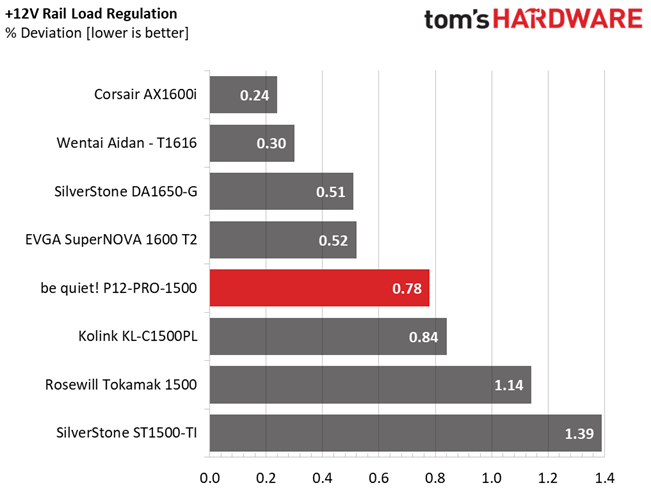
Results 1-8: Load Regulation
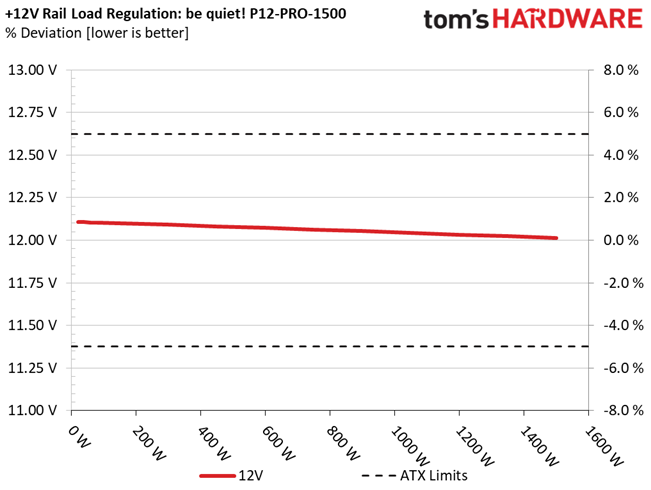
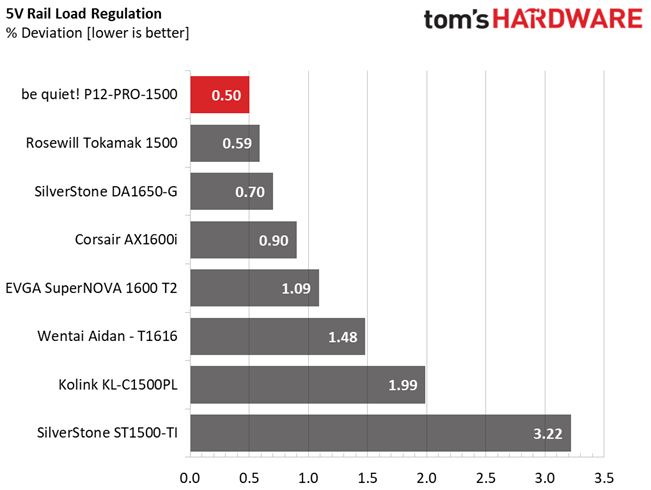
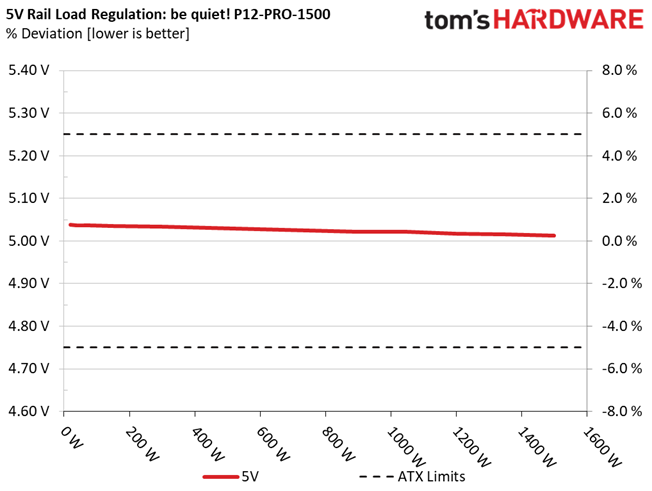
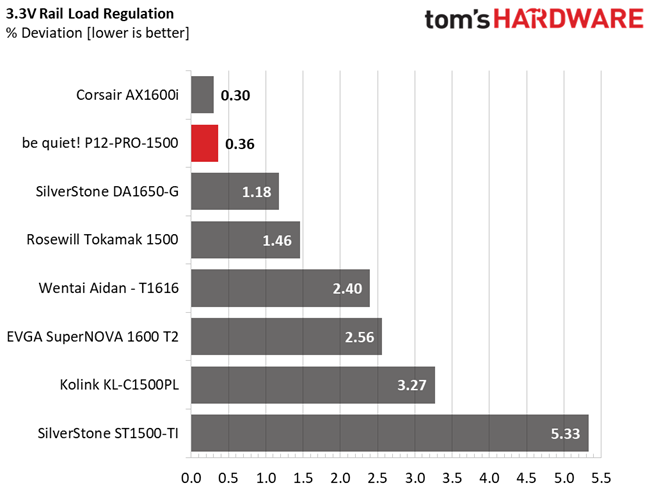


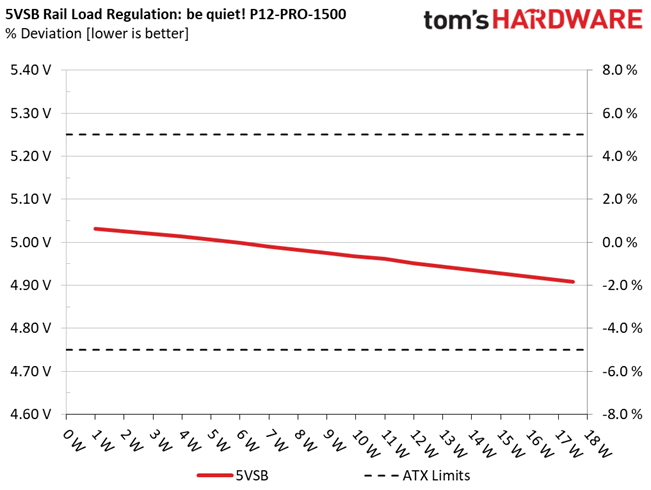
Load regulation is tight but not tight enough to meet the competition, even the analog platforms from Super Flower and SilverStone. On the other hand, the minor rails achieve fantastic performance.
Hold-Up Time
Put simply; hold-up time is the amount of time that the system can continue to run without shutting down or rebooting during a power interruption.
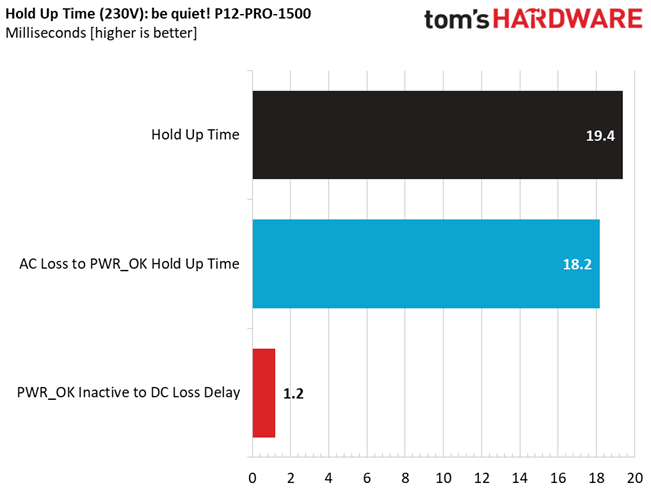
Results 9-12: Hold-Up Time

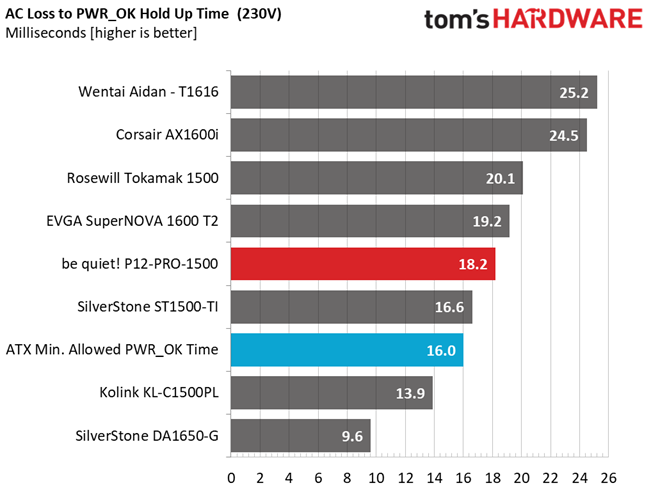
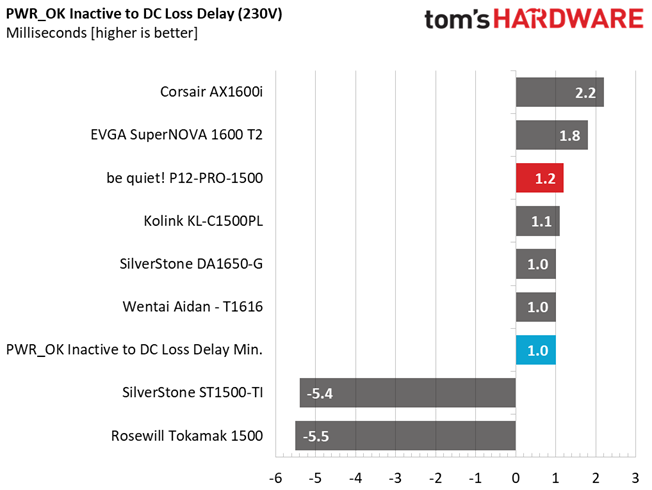
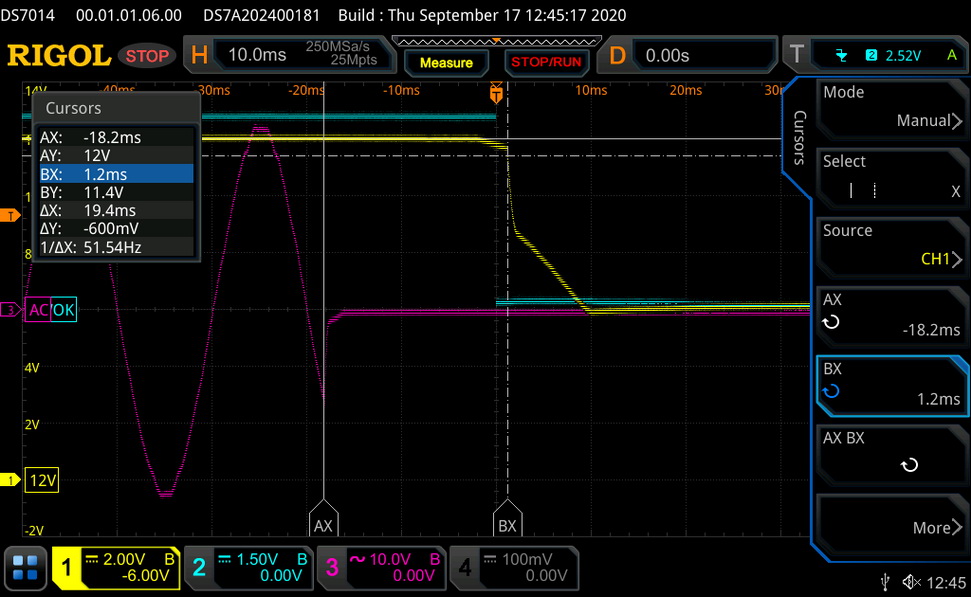

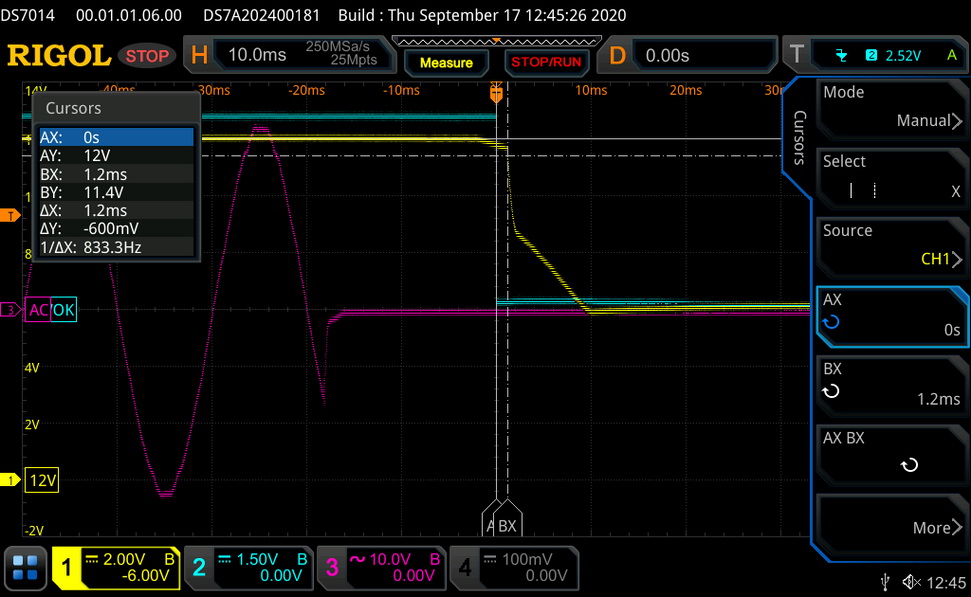
The hold-up time is notably higher than 17ms, thanks to the large capacity of the bulk caps.
Inrush Current
Inrush current, or switch-on surge, refers to the maximum, instantaneous input current drawn by an electrical device when it is first turned on. A large enough inrush current can cause circuit breakers and fuses to trip. It can also damage switches, relays, and bridge rectifiers. As a result, the lower the inrush current of a PSU right as it is turned on, the better.
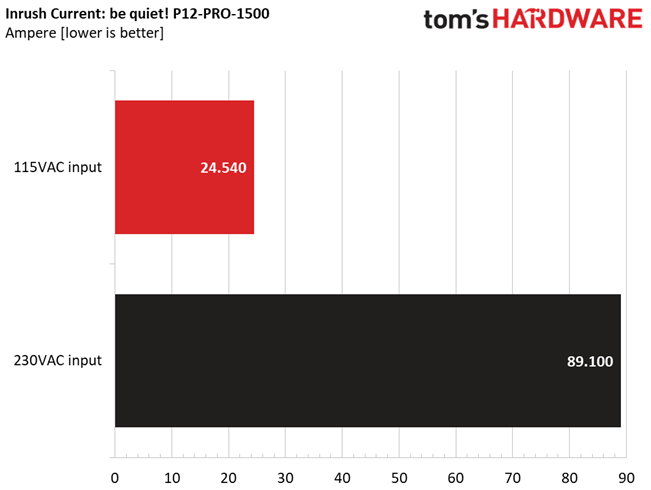
Results 13-14: Inrush Current

Inrush current is low with 115V and remains below 90A with 230V. Given the capacity of the three bulk caps and the PSU's 1500W max power, we cannot expect much lower inrush currents with 230V.
Get Tom's Hardware's best news and in-depth reviews, straight to your inbox.
Leakage Current
In layman's terms, leakage current is the unwanted transfer of energy from one circuit to another. In power supplies, it is the current flowing from the primary side to the ground or the chassis, which in the majority of cases is connected to the ground. For measuring leakage current, we use a GW Instek GPT-9904 electrical safety tester instrument.
The leakage current test is conducted at 110% of the DUT's rated voltage input (so for a 230-240V device, we should conduct the test with 253-264V input). The maximum acceptable limit of a leakage current is 3.5 mA and it is defined by the IEC-60950-1 regulation, ensuring that the current is low and will not harm any person coming in contact with the power supply's chassis.
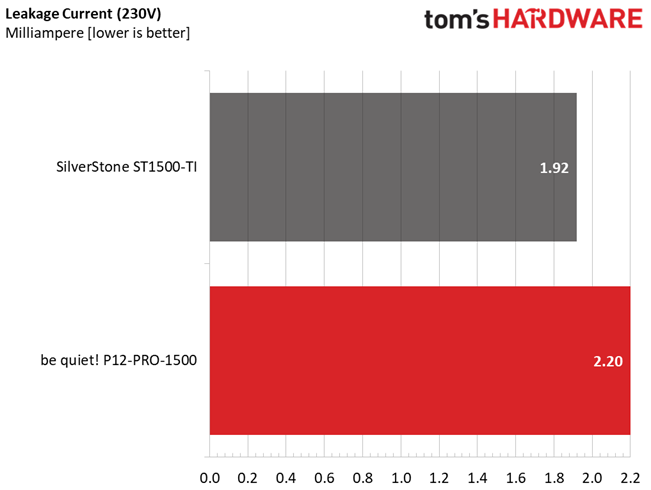
The high amount of Y caps used in the EMI filter increases leakage current. The larger the Y caps are, the better attenuation of asymmetrical interferences (at high frequencies), but the increased capacity also leads to higher leakage currents.
10-100% Load Tests
These tests reveal the PSU's load regulation and efficiency levels under high ambient temperatures. They also show how the fan speed profile behaves under increased operating temperatures.
| Test # | 12V | 5V | 3.3V | 5VSB | DC/AC (Watts) | Efficiency | Fan Speed (RPM) | PSU Noise (dB[A]) | Temps (In/Out) | PF/AC Volts |
| 1 | 10.614A | 1.986A | 1.992A | 0.999A | 150.014 | 91.839% | 547 | 8.8 | 41.55°C | 0.902 |
| 12.099V | 5.035V | 3.311V | 5.006V | 163.345 | 45.19°C | 115.18V | ||||
| 2 | 22.261A | 2.982A | 2.990A | 1.201A | 300.067 | 93.794% | 547 | 8.8 | 42.15°C | 0.995 |
| 12.091V | 5.033V | 3.310V | 4.999V | 319.923 | 46.23°C | 115.14V | ||||
| 3 | 34.248A | 3.480A | 3.489A | 1.403A | 449.835 | 93.942% | 549 | 8.6 | 42.97°C | 0.997 |
| 12.082V | 5.030V | 3.309V | 4.990V | 478.841 | 47.73°C | 115.10V | ||||
| 4 | 46.277A | 3.979A | 3.989A | 1.606A | 599.856 | 93.647% | 551 | 8.5 | 43.12°C | 0.997 |
| 12.072V | 5.027V | 3.308V | 4.982V | 640.551 | 48.67°C | 115.11V | ||||
| 5 | 57.988A | 4.976A | 4.992A | 1.810A | 750.022 | 93.081% | 551 | 8.5 | 43.46°C | 0.999 |
| 12.063V | 5.025V | 3.306V | 4.975V | 805.771 | 49.74°C | 115.13V | ||||
| 6 | 69.715A | 5.976A | 5.991A | 2.000A | 900.021 | 92.365% | 681 | 15.7 | 43.64°C | 0.999 |
| 12.053V | 5.022V | 3.305V | 4.967V | 974.422 | 50.47°C | 115.17V | ||||
| 7 | 81.463A | 6.973A | 6.994A | 2.218A | 1050.263 | 91.423% | 683 | 15.8 | 43.71°C | 0.999 |
| 12.044V | 5.021V | 3.304V | 4.961V | 1148.799 | 51.58°C | 115.19V | ||||
| 8 | 93.240A | 7.976A | 7.995A | 2.424A | 1200.375 | 90.338% | 897 | 23.6 | 44.28°C | 0.999 |
| 12.033V | 5.017V | 3.302V | 4.952V | 1328.766 | 52.71°C | 115.18V | ||||
| 9 | 105.437A | 8.477A | 8.484A | 2.424A | 1350.189 | 89.337% | 1359 | 37.8 | 45.63°C | 0.998 |
| 12.023V | 5.015V | 3.301V | 4.951V | 1511.347 | 54.65°C | 115.17V | ||||
| 10 | 117.193A | 8.982A | 9.000A | 3.566A | 1499.942 | 88.447% | 1742 | 44.7 | 45.81°C | 0.998 |
| 12.012V | 5.012V | 3.300V | 4.908V | 1695.858 | 55.75°C | 115.16V | ||||
| CL1 | 0.120A | 18.001A | 18.000A | 0.000A | 151.594 | 85.991% | 553 | 8.5 | 43.95°C | 0.909 |
| 12.087V | 5.037V | 3.304V | 5.069V | 176.290 | 49.85°C | 115.17V | ||||
| CL2 | 125.024A | 1.000A | 1.000A | 1.000A | 1515.975 | 88.802% | 1457 | 38.9 | 45.38°C | 0.998 |
| 12.019V | 5.016V | 3.306V | 4.990V | 1707.146 | 55.50°C | 115.11V |
The PSU doesn't have the slightest problems delivering full load at high operating temperatures. Moreover, the PF readings are high, thanks to the adequately tuned interleaved PFC circuit. Some manufacturers don't pay much attention to power factor, but it is as important as efficiency. Briefly, the higher the power factor, the less energy goes wasted back to the mains network. Although residential consumers do not have to pay for apparent power, it is of immense importance for all of us to waste as little energy as possible.
20-80W Load Tests
In the following tests, we measure the PSU's efficiency at loads significantly lower than 10% of its maximum capacity (the lowest load the 80 PLUS standard measures). This is important for representing when a PC is idle with power-saving features turned on.
| Test # | 12V | 5V | 3.3V | 5VSB | DC/AC (Watts) | Efficiency | Fan Speed (RPM) | PSU Noise (dB[A]) | PF/AC Volts |
| 1 | 1.226A | 0.496A | 0.498A | 0.199A | 19.994 | 61.200% | 547 | 8.8 | 0.722 |
| 12.107V | 5.038V | 3.313V | 5.032V | 32.670 | 115.17V | ||||
| 2 | 2.452A | 0.994A | 0.994A | 0.398A | 39.983 | 79.908% | 547 | 8.8 | 0.782 |
| 12.106V | 5.037V | 3.312V | 5.026V | 50.036 | 115.17V | ||||
| 3 | 3.681A | 1.489A | 1.495A | 0.598A | 60.012 | 85.052% | 546 | 8.9 | 0.817 |
| 12.105V | 5.037V | 3.312V | 5.019V | 70.559 | 115.18V | ||||
| 4 | 4.905A | 1.985A | 1.993A | 0.798A | 79.961 | 87.811% | 547 | 8.8 | 0.842 |
| 12.103V | 5.036V | 3.311V | 5.013V | 91.060 | 115.18V |
Efficiency with 20W is dead low since this load level is close to 1.3% of the PSU's max-rated-capacity, and the new ATX spec states that the 70% threshold applies to 2% of max power.
2% or 10W Load Test
Intel plans on raising the ante at efficiency levels under ultra-light loads. So from July 2020, the ATX spec will require 70% and higher efficiency with 115V input. The applied load is only 10W for PSUs with 500W and lower capacities, while for stronger units we dial 2% of their max-rated-capacity.
| Test # | 12V | 5V | 3.3V | 5VSB | DC/AC (Watts) | Efficiency | Fan Speed (RPM) | PSU Noise (dB[A]) | PF/AC Volts |
| 1 | 2.248A | 0.325A | 0.325A | 0.063A | 30.245 | 69.808% | 542 | 9.1 | 0.766 |
| 12.107V | 5.032V | 3.311V | 5.031V | 43.326 | 115.17V |
The PSU is very close to 70% with 2% load, so we will mark it as a pass here.
Efficiency and Power Factor
Next, we plotted a chart showing the PSU’s efficiency at low loads, and loads from 10 to 110% of its maximum rated capacity. The higher a PSU’s efficiency, the less energy goes wasted, leading to a reduced carbon footprint and lower electricity bills. The same goes for Power Factor.

Results 15-18: Efficiency

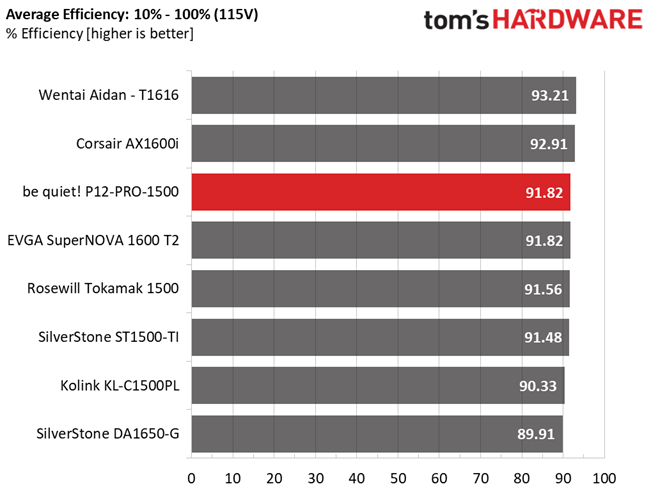

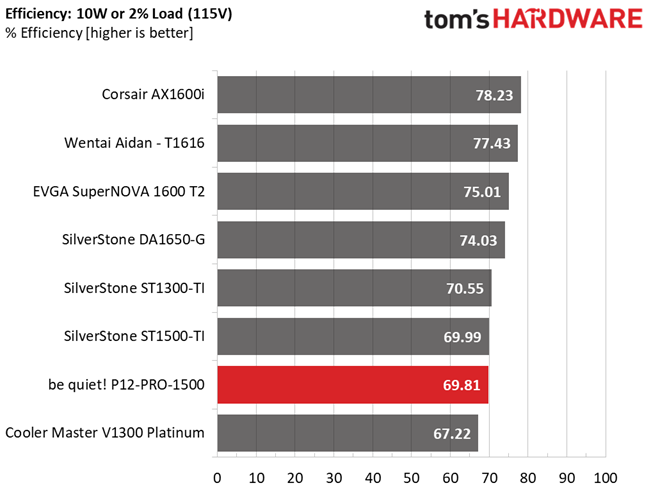

This is a highly efficient platform, but it cannot keep up with the digital competition, and with 2% load, it is second, from the bottom.
5VSB Efficiency
| Test # | 5VSB | DC/AC (Watts) | Efficiency | PF/AC Volts |
| 1 | 0.100A | 0.502 | 76.176% | 0.064 |
| 5.018V | 0.659 | 115.17V | ||
| 2 | 0.250A | 1.253 | 77.826% | 0.146 |
| 5.012V | 1.610 | 115.16V | ||
| 3 | 0.550A | 2.752 | 78.472% | 0.264 |
| 5.002V | 3.507 | 115.16V | ||
| 4 | 1.000A | 4.988 | 77.719% | 0.361 |
| 4.987V | 6.418 | 115.15V | ||
| 5 | 1.500A | 7.456 | 77.699% | 0.416 |
| 4.969V | 9.596 | 115.14V | ||
| 6 | 3.501A | 17.141 | 76.301% | 0.498 |
| 4.896V | 22.465 | 115.12V |

Results 19-20: 5VSB Efficiency
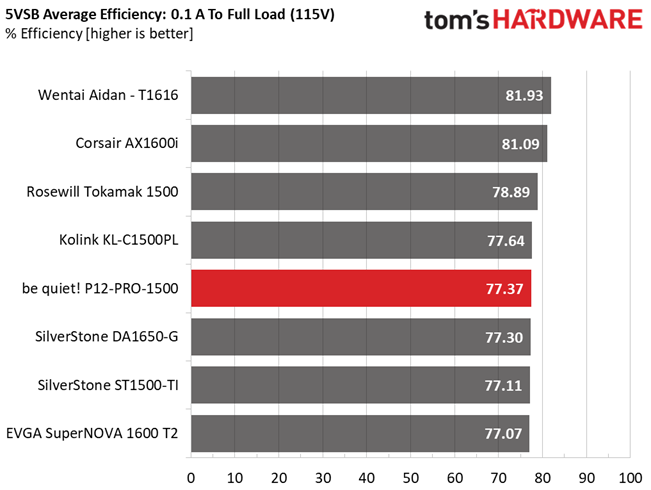
CWT has much more efficient 5VSB circuits in its portfolio, so, weirdly, it didn't use one of them in this platform. Not that we have a serious problem with the existing one, but when you want to meet high-end competitors like the Corsair AX1600i and the Wentai T1616, you have to bring your top guns into the fight.
Power Consumption In Idle And Standby
| Mode | 12V | 5V | 3.3V | 5VSB | Watts | PF/AC Volts |
| Idle | 12.108V | 5.030V | 3.311V | 5.029V | 12.065 | 0.551 |
| 115.2V | ||||||
| Standby | 0.032 | 0.003 | ||||
| 115.2V |
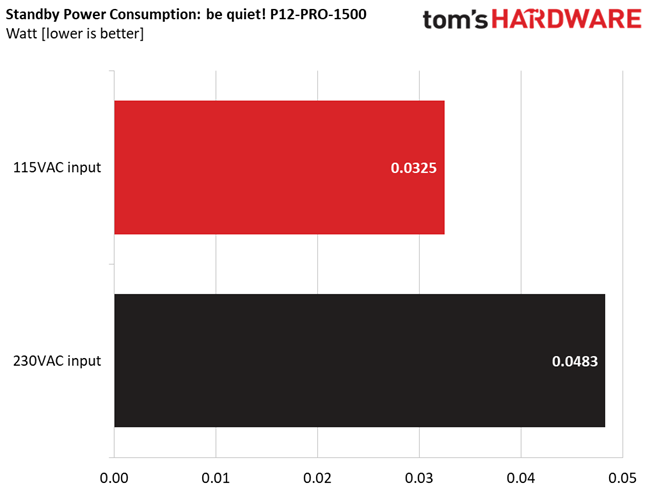
Results 21-22: Vampire Power
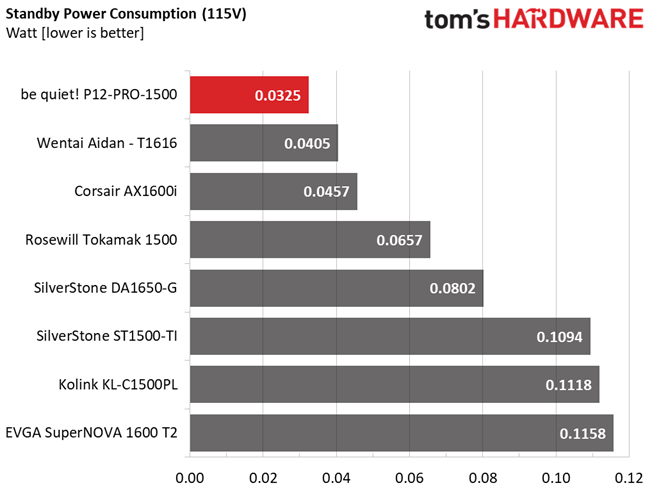
Vampire power consumption is dead low, helping the 5VSB circuit achieve high efficiency at super light loads.
Fan RPM, Delta Temperature, and Output Noise
All results are obtained between an ambient temperature of 37 to 46 degrees Celsius (98.6 to 116.6 degrees Fahrenheit).
be quiet! instructed CWT to keep the fan speed profile as relaxed as possible, without jeopardizing the PSU's reliability.
The following results were obtained at 30 to 32 degrees Celsius (86 to 89.6 degrees Fahrenheit) ambient temperature.
There is no passive operation, but this is fine with us since the fan operates at low speeds, even with loads exceeding 1000W. The PSU enters the 30-35 dBA zone once the load reaches 1150W, and it moves to the next region (35-40 dBA) with higher than 1300W loads. All in all, under normal ambient temperatures, you will barely hear this PSU's fan.
MORE: Best Power Supplies
MORE: How We Test Power Supplies
MORE: All Power Supply Content
Current page: Load Regulation, Hold-Up Time, Inrush & Leakage Current, Efficiency and Noise
Prev Page Specifications and Part Analysis Next Page Protection Features, DC Power Sequencing, Cross-Load Tests and Infrared Images
Aris Mpitziopoulos is a contributing editor at Tom's Hardware, covering PSUs.
-
patrick47018 Reply
Try the EVGA G+ instead, or you could buy the Dark Power Pro 12 on Amazon right now with the 1200W in stock and the 1500W coming and able to be ordered.tamalero said:Been trying to find a Corsair AX and EVGA T2 and nobody has them on stock! -
mac_angel I've never seen a power supply with an "overclock" jumper/setting. You mention that this has it, and that it combines the 'virtual' single 12v rails into a single big one, but not what that means.Reply

